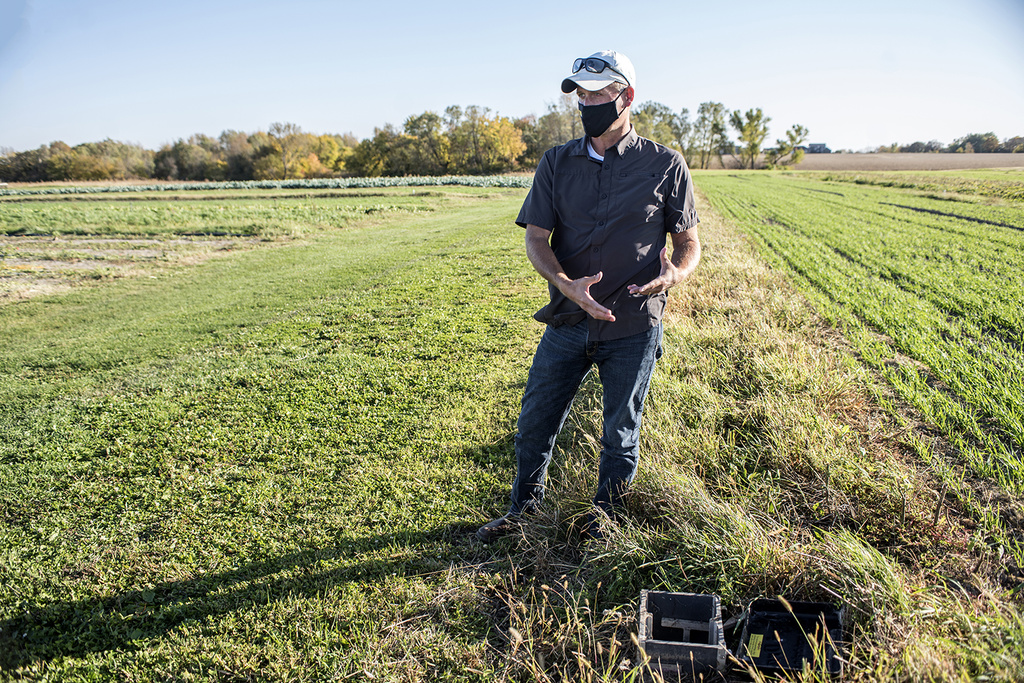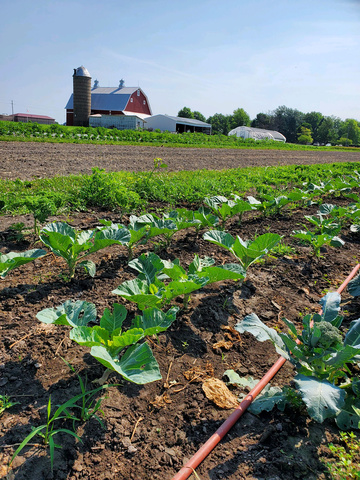by Jacqueline Hartling Stolze
In Iowa, we hear a lot about the rural-urban divide. Where we live can color our work, our social lives, our politics, and even our perceptions of ourselves and our neighbors. But near Iowa City, there’s a place for all Iowans, where urban and rural meet in a unique and productive way — the Johnson County Historic Poor Farm.

AN UNDERGROUND WETLAND
Drive down any country road in Iowa, and you’ll likely see plenty of grassed waterways. It’s one of the most common, best accepted soil conservation practices in the state. These strips of grass serve as stable channels for the flow of runoff in erosion-prone areas.
But this one, at the Johnson County Historic Poor Farm, is different.
IIHR researcher Craig Just, who is also an associate professor of civil and environmental engineering at the University of Iowa, is leading a tour of conservation projects at the poor farm. He lifts the top of a box-like structure that opens onto a vertical shaft plunging about four feet into the earth. Known as agriculture drainage water management (or conservation drainage), the structure taps into the existing tile line. The tile line flows into a water-control structure with adjustable slats inside to control the flow, storage, and release of the connected tile system. Adjustable slats or “weirs” allow the farmer to raise or lower the water table depending on the conditions.
“It’s kind of like an underground wetland,” Just explains. “In a drought year, you can bank water and slowly release it.” Conservation drainage also supports improved water quality by reducing unnecessary tile drainage.
Just gives the credit for this reactive grassed waterway to his colleague, Iowa Geological Survey (IGS) researcher Keith Schilling, who developed the practice. Its implementation here for research and demonstration allows study of its effectiveness for crop management and water-quality improvement.
CONNECTING WITH THE LAND
The Johnson County Historic Poor Farm is set on the west edge of Iowa City, on the boundary between city and farm. It’s a welcoming setting for exchanges about conservation, soil health, local food production, and much more.

Johnson County officials established the JCHPF in 1855 as a home for Iowans with mental illness, disabilities, or financial problems. At the time, it was widely thought that hard work and fresh air were beneficial for the “poor unfortunates” who lived there because they had nowhere else to go. The farm was expected to be self supporting, and residents provided much of the labor.
Until recently, row crops dominated the 160-acre farm. A few buildings from the early days survive, such as a barn that provided a home for dairy cows, a smaller white asylum building, and a handful of other structures.
Today, the JCHPF provides a place for Iowans, both rural and urban, to explore their connections with the land and local history.
Jason Grimm is interim executive director of the Iowa Valley Resource Conservation and Development’s nonprofit organization, which manages the JCHPF. He was part of the team that helped develop a master plan for the farm, in conjunction with Johnson County and HBK Engineering. The plan focuses on five goals: local food production, historic preservation, education, recreation, and conservation.
Grimm and his team stayed on to help implement the plan. Iowa Valley RC & D also rents five acres of land for Grow Johnson County, which plants, harvests, and freely distributes about 30,000 pounds of fresh vegetables every year. This free produce helps support Johnson County food pantries, meal programs, daycare centers, and more.
JCHPF also offers a place for aspiring farmers to learn about different farming practices through apprenticeships and workshops. They can even rent a few acres to get their farming operations started.
CONNECTIONS AND CONVERSATIONS
Just hopes his research will help support that diversity. He’s excited to connect with Iowans, especially farmers, at the JCHPF.
“I’m an Iowan,” Just says. “I thought I knew a lot about farming.” Then he realized how often the discussions about conservation and water quality didn’t include any input from farmers themselves.
“How about having conversations with farmers instead of about farmers?” Just asks. The JCHPF is the perfect place to bridge the gaps between rural and urban Iowans, he says, and to work toward a more unified understanding of the issues we face.
Just leads a research project supported by a grant from the Environmental Protection Agency (EPA) titled “Connecting Rural and Peri-Urban Farmers to Demonstrate and Disseminate Innovative Nutrient and Sediment Reduction Practices.” The project focuses exclusively on installation of nitrogen-removing
wetlands, ponds, and native vegetation, along with water-quality data collection, to achieve a better understanding of how well they can improve water quality and flood storage. Just says he’s looking forward to many productive conversations with farmers about the usefulness of these practices.

Just credits IIHR’s Kate Giannini for the inspiration to use the JCHPF as a site for the EPA project. “She planted the initial seed,” he says. Giannini is an Iowa Flood Center staff member who serves as communication specialist for the Iowa Watershed Approach (IWA), a five-year, $97M project that seeks to reduce flooding and improve water quality in nine Iowa watersheds. Previously, she worked as a Johnson County soil and water conservation coordinator. Through her work there, she met Jason Grimm and got involved in transitioning the JCHPF to its new mission.
Just says Giannini’s idea for the poor farm was a stroke of brilliance. The JCHPF’s setting on the border between city and countryside allows him to make connections with the people who live and farm in the watershed. Just chose several other strategic locations for project demonstration sites, all convenient to the people who farm in the watershed as well as their urban neighbors.
It was a win-win as far as Giannini is concerned. As an Iowa City native, Giannini has strong ties to the community. Her grandfather, a local grocer, delivered goods to the poor farm in the 1960s. And working with Grimm on the initial reimagining of the poor farm was, she says, one of the most rewarding projects she has ever worked on. “When this opportunity came up to work out there again, I was ecstatic,” she says.
The project also takes advantage of the partnerships and expertise already in place, thanks to the IWA’s extensive collaboration that includes local government, nonprofits, researchers, educators, and the public.
PARTNERING WITH BACTERIA
UI graduate student Emily Schmitz says she appreciates the research opportunities at the JCHPF. Her work focuses on using bacteria to clean up pollution — in this case, nitrate. By understanding where the bacteria survive and why, Schmitz hopes to help develop strategies that favor these bacteria and the clean-up processes they perform.

“I learned a ton and it was a wonderful experience,” Schmitz says. “Everyone I have met working on or with the poor farm has been really amazing! The work they are doing is so valuable and important to the community.”
She especially appreciated the chance to observe the Iowa Geological Survey’s (IGS) drill rig in action, putting in groundwater monitoring wells for the EPA project. The wells allow researchers to learn about pollutants in the groundwater and to better regulate tile drainage in support of improved production.
Soon the instrumentation on the farm will also include one of the Iowa Flood Center’s hydrostations, which monitor weather conditions, soil moisture and temperature, humidity, and other variables. The data will be available online in near real time. With this information, Grimm says, they can make better decisions on the farm, and share their methods and data with other stakeholders.
A HOPEFUL FUTURE
The poor farm tour ends at a stream on the south edge of the property, where a water-quality sensor at the tile outlet provides a continuous flow of data, all displayed online. This information will allow Just and his team to monitor the results of conservation practices installed at the poor farm.
Dusk is not far off now, and the wind has died back a bit. The darkening shadows cast a slight chill over the group. The stream is not far from an old, unmarked cemetery where more than 300 poor farm residents were buried (the exact number is unknown). It’s a reminder of the lives that were lived here, and for some, ended here.
Yet life goes on at the farm, and progress is taking us to a hopeful future. In this setting, Just says, the whole project just seems to fit, somehow.
“I go to bed smiling,” he says.
